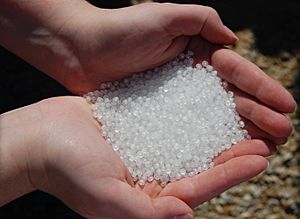Plastic resin pellet pollution facts for kids
Plastic resin pellet pollution is a type of marine debris that comes from tiny plastic pieces used to make bigger plastic items. These small plastic pellets, often called nurdles, are made before they are melted down to form the plastic products we use. Nurdles often spill during their making and when they are moved around. When they get into the environment, they cause pollution in our oceans and on beaches.
A big oil company, Sinopec, has said that nurdles are not poisonous or dangerous by themselves.
Contents
What Are Nurdles?

Nurdles are a type of microplastics. This means they are tiny plastic pieces that were made small on purpose. They are usually about the size of a lentil, from 1 to 5 millimeters across.
Every year, about 27 million tons (which is 60 billion pounds) of nurdles are made in the United States. Just one pound of plastic pellets can contain around 25,000 nurdles!
How Nurdles Harm the Environment
Nurdles are a big part of the trash found in our oceans. In one study of beaches in Orange County, California, nurdles were the most common type of pollution found. A study in Scotland even found that nurdles on beaches could be covered in harmful germs like E. coli.
Nurdles that escape from plastic factories and get into rivers or oceans become a major source of plastic pollution. These tiny plastic pellets are often found on beaches and in the sand. They are usually made of common plastics like polyethylene or polypropylene.
When sea creatures eat nurdles, the pellets can get stuck in their stomachs. Nurdles can also release harmful chemicals, like phthalates, into the animals. These tiny plastics can also pick up other dangerous pollutants from the seawater. For example, nurdles found near Japan had levels of certain chemicals that were a million times higher than in the surrounding water.
Tiny plastic beads, called microbeads, that are used in some face washes and scrubs can also end up in the water.
Major Nurdle Spills and Events
Nurdle spills can happen in many ways, from storms to truck crashes. Here are a few examples:
2012 Spills
- In 2012, the San Francisco Bay had several nurdle spills that needed cleaning up.
- In Hong Kong, a strong storm called Typhoon Vicente blew containers off a ship. These containers were carrying over 150 tons of plastic pellets. The nurdles spilled into the sea and washed up on many southern Hong Kong beaches. This spill harmed marine life and killed fish on local farms.
2017 Spills
- About two billion nurdles (49 tons) spilled from a shipping container in Durban Harbor in South Africa. This required a lot of cleanup work. These nurdles even traveled far, washing up on shores in Western Australia.
- The Great Nurdle Hunt took place across the United Kingdom in June 2017. This event encouraged people to look for nurdles on beaches and share photos. This helped a charity called Fidra understand how widespread nurdle pollution was. Earlier hunts in 2017 found that 73% of UK beaches had nurdle pollution.
2018 Spills
- A semi-truck crash in Pennsylvania led to bright blue nurdles spilling into Pocono Creek and other waterways.
2020 Spills
- In August 2020, a shipping container with 25 tons of nurdles fell off a ship into the Mississippi River in New Orleans during a thunderstorm. No official cleanup happened because nurdles are not classified as hazardous materials.
2021 Spills
- On June 2, 2021, the cargo ship X-Press Pearl sank off the coast of Sri Lanka. It spilled chemicals and billions of nurdles, causing the worst environmental disaster in that country's history.
What's Being Done to Help?
The plastic industry is now paying more attention to the problem of nurdle spills.
- Operation Clean Sweep was started in 2001 by plastic industry groups. Its goal is to have zero pellet loss from plastic factories. This program gives companies a guide and training to help them reduce spills. However, companies don't have to report how many pellets they spill.
- In 2008, California passed a "nurdle law." This law specifically says that pre-production plastic pellets (nurdles) are a pollutant.
Raising Awareness About Nurdles
People are also working to make others aware of nurdle pollution:
- In 2013, artist Maria Cristina Finucci created The Garbage Patch State at UNESCO in Paris. This project aims to raise awareness about ocean pollution.
- The Great Nurdle Hunt is a worldwide project where everyday people help map out plastic pellet pollution. The information collected is used to talk to companies and lawmakers to find ways to stop more nurdle pollution.
See also
 In Spanish: Contaminación por pellets de plástico para niños
In Spanish: Contaminación por pellets de plástico para niños
- Microbead
- Microplastics


